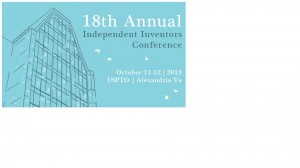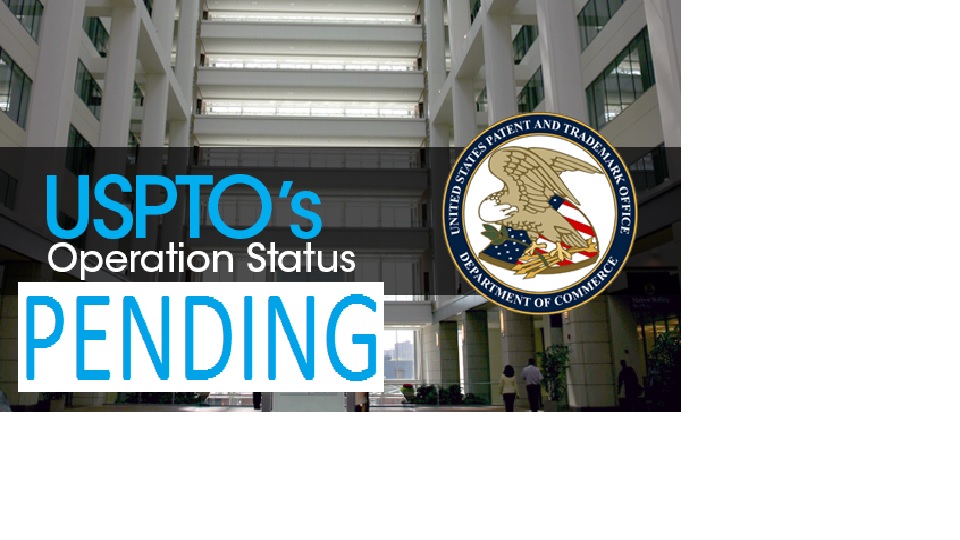USPTO does have a plan, namely, Plan for Orderly Shutdown Due to Lapse of Congressional Appropriations,(hereinafter, “The Plan”). The USPTO has sufficient funds from other than FY14 appropriations to continue full operations for approximately 4 weeks. Therefore, all 11,789 employees of the USPTO will be excepted for approximately up to 4 weeks following a lapse in appropriations. After this time period, the USPTO will execute the Plan as described in the “Plan” and excepted employees will be listed under the category of “Employees, not otherwise exempt, to be retained to protect life and property”.
Patent
18th Annual Independent Inventors Conference. October 11 – 12, 2013, USPTO, Alexandria, VA
Register now for the 18th Annual Independent Inventors Conference

18th Annual Independent Inventors Conference. October 11-12, 2013. USPTO, Alexandria, Va.
The United States Patent and Trademark Office’s (USPTO) 18th Annual Independent Inventors Conference will be held October 11-12, 2013. After taking place in various regions around the country, the annual conference comes home to the USPTO headquarters in Alexandria, Va.
For two days, independent inventors and small business owners will have an unparalleled opportunity to learn, network, and jumpstart their creative endeavors. Experts and senior officials from the USPTO, including Deputy Under Secretary of Commerce for Intellectual Property and Deputy Director of the USPTO Teresa Stanek Rea and Commissioner for Patents Margaret (Peggy) Focarino, will present valuable information on patents, trademarks, and other intellectual property (IP) matters. Successful business owners and inventors will relate their inspiring personal experiences in bringing their dreams to market. In addition, representatives from government, legal, and business development entities will discuss commercial best practices and the various resources offered by their organizations. Each attendee will have an exclusive opportunity to meet one-on-one with a USPTO expert or IP professional and discuss innovation matters important to them. A pre-conference workshop is available the evening of October 10 to help conference-goers prepare for getting the most out of their experience.
Keynoting the event is prolific inventor Woody Norris, who is responsible for a wide range of technologies, including the hypersonic sound focusing device.
Attendees will also be able to choose from a variety of panels and breakout sessions that address specific intellectual property topics relevant to the modern inventor and small business owner. These sessions include hands-on workshops on patent and trademark application filing, prior art searching, and recent changes in legislation that affect business owners and inventors, among many other topics.
The 18th Annual Independent Inventors Conference promises to be a great opportunity. We look forward to seeing you in October!
For more information, contact the USPTO’s Office of Innovation Development at 571-272-8877 or 866-767-3848 or email independentinventor@uspto.gov.
Aaron Swartz…Peace Be With You…

http://blog.reddit.com/2013/01/aaronsw-1986-2013.html
Sad News…NYT reported by Ravi Somaiya.
Aaron Swartz, was found dead in his New York apartment. Mr. Swartz, a wizard of the internet and only 26 years of age, had apparently hanged himself, and that a friend of Mr. Swartz’s had discovered the body. At 14, Mr. Swartz helped create RSS, the nearly ubiquitous tool that allows users to subscribe to online information. He formed a company that merged with Reddit, the popular news and information site. He also co-founded Demand Progress, a group that promotes online campaigns on social justice issues — including a successful effort, with other groups, to oppose a Hollywood-backed Internet piracy bill.
Mr. Wolf said he would remember his nephew, who had written in the past about battling depression and suicidal thoughts, as a young man who “looked at the world, and had a certain logic in his brain, and the world didn’t necessarily fit in with that logic, and that was sometimes difficult.”
CFR – Code of Federal Regulations Title 21 Gets New Year Proposal for Foodborne Illness Standards
The New FDA Food Safety Modernization Act (FSMA)
FDA proposes new food safety standards for foodborne illness prevention and produce safety
The FDA Food Safety Modernization Act (FSMA), the most sweeping reform of our food safety laws in more than 70 years, was signed into law by President Obama on January 4, 2011. It aims to ensure the U.S. food supply is safe by shifting the focus from responding to contamination to preventing it.
AGENCY: Food and Drug Administration, HHS.
ACTION: Proposed rule.
SUMMARY: The Food and Drug Administration (FDA) is proposing to amend its regulation for Current Good Manufacturing Practice In Manufacturing, Packing, or Holding Human Food
(CGMPs) to modernize it and to add requirements for domestic and foreign facilities that are required to register under the Federal Food, Drug, and Cosmetic Act (the FD&C Act) to establish and implement hazard analysis and risk-based preventive controls for human food. FDA also is proposing to revise certain definitions in FDA’s current regulation for Registration of Food Facilities to clarify the scope of the exemption from registration requirements provided by the FD&C Act for “farms.” FDA is taking this action as part of its announced initiative to revisit the CGMPs since they were last revised in 1986 and to implement new statutory provisions in the FD&C Act. The proposed rule is intended to build a food safety system for the future that makes modern, science-, and risk-based preventive controls the norm across all sectors of the food system.
Thomas Jefferson School of Law TM and USPTO
Thomas Jefferson School of Law and the USPTO
TJSL’s New Trademark Clinic Files First USPTO Application
 (From left) Melissa Adao, Jeff Berneking and Tim Dennison
(From left) Melissa Adao, Jeff Berneking and Tim Dennison
Thomas Jefferson School of Law’s Trademark Clinic has filed its first trademark application with the U.S. Patent and Trademark Office (USPTO) on behalf of a client, marking a major milestone for the recently established clinical program.
The USPTO announced in early August that TJSL is one of nine additional law schools in the nation selected for the Trademark Law School Clinic Certification Pilot Program, which allows TJSL students to practice trademark law before the USPTO under the guidance of a faculty supervisor.
The filing of the first application this week proved to be an exciting moment for everyone involved with the new TJSL Trademark Clinic, which is designed to provide assistance to small businesses, such as applicant Outreach Through Dance, and independent inventors who can’t afford market rates for filing trademark and patent applications with the USPTO. Outreach Through Dance is a San Diego organization that produces dance events to benefit charitable organizations nationally and internationally.
“The program was able to help Outreach Through Dance with their trademark filings – something they probably couldn’t have afforded without the resources of a student-driven clinic like the Trademark Clinic,” according to Tim Dennison, the clinic’s director.
“We needed both legal advice and services but, as a small charitable business, we couldn’t fit them into the budget,” says Melissa Adao, founder and CEO of Outreach Through Dance. “We learned about the Thomas Jefferson School of Law Small Business Law Center and the Trademark Clinic, in particular, at the Little Italy Art Fair.
“This was a perfect solution for us,” Adao adds. “We got great legal advice and had our trademark filed and we were able to keep to our budget. We are now going back to the SBLC for help with forming a non-profit. We would strongly recommend to other small businesses in the community to look into the services offered at these free clinics.”
The TJSL Trademark and Patent Clinics were established earlier this year, after the school applied to the USPTO to be part of its law school pilot programs. In mid-July, the USPTO announced that Thomas Jefferson School of Law would be the only California law school to participate in its Patent Law School Clinic Certification Pilot Program. Two weeks later, TJSL learned that its Trademark Clinic also was selected.
The USPTO Selection Committee chose schools with the greatest potential for success, including those with strong Intellectual Property curriculums, like TJSL’s, that support students’ hands-on learning, a commitment to networking in the community, comprehensive pro bono services and excellent case management systems. Students working in the clinics received mandatory training from the USPTO.
According to the USPTO, “the program allows law students enrolled in a participating law school’s clinic program to practice Intellectual Property Law before the USPTO under the strict guidance of a Law School Faculty Clinic Supervisor. The program currently consists of students practicing in both patent and trademark law before the USPTO. The program is administered by the Office of Enrollment and Discipline. The Director of the Office of Enrollment and Discipline grants the law students limited recognition to practice before the Office.
“Students gain experience drafting and filing either patent applications or trademark applications for clients of the law school clinic. Further, as they are authorized to practice before the USPTO, they gain experience answering Office Actions and communicating with either patent examiners or trademark examining attorneys for the applications they have filed.”
A special feature of the pilot programs is that the USPTO will expedite the application review process for those filed by the law students. This will greatly benefit the clients of TJSL’s Trademark and Patent Clinics as the normal application review process can take years.
The Trademark Clinic is just one of the free clinics TJSL operates to help people in need of legal assistance, from struggling veterans, to small business people, to artists and art organizations, to individual taxpayers, to those involved in small claims and probate court cases that need the services of trained mediators.
“I feel very proud to be a part of the Trademark Clinic at Thomas Jefferson. I think all of the practical clinic programs: the Veteran’s Clinic, the Small Business Law Center, VITA Tax Clinic, the Patent Clinic and the Trademark Clinic are fantastic resources, both for the students and the community,” said Dennison. “This is a great program and Dean Hasl and the rest of the TJSL staff and faculty are to be congratulated for having the foresight, not only to focus on practical training for the students, but also for doing it such a way that the community benefits.”
Coursera.org
Free Educational Website!
- Coursera.org offers online classes in many different subject matters online for free. They offer courses in a wide range of fields, including Gamification, Poetry, Electrical and Materials Engineering, Computer Science, Biology & Life Sciences, and many more. The classes are taught by some of the leading institutions in the world. Some classes even offer a certificate of completion.
USPTO Friendly Access to MPEP and TMEP
Press Release, 12-57
USPTO Connects Innovators to Key Patent and Trademark Resources
New Web-Based Search Engine Means Easier Access and More Transparency
Washington – The U.S. Department of Commerce’s United States Patent and Trademark Office (USPTO) is making its patent and trademark examining manuals more accessible to the public through a new, user-friendly search tool. The Manual of Patent Examining Procedure (MPEP) and Trademark Manual of Examining Procedure (TMEP) search tools, which work like an Internet search engine, are available at tmep.uspto.gov and mpep.uspto.gov.
The new tools are part of a larger, agency-wide effort to better connect innovators to the USPTO’s many free resources and to make the agency’s procedures as transparent as possible. Individuals will be able to navigate through the manuals using a table of contents, or perform searches by typing words in a search box. Search results will be ranked by relevance and search terms highlighted in the body of the document. Sections of the manual can be printed or exported to PDF using typical browser functionality. The primary benefit of the new system to users and the USPTO is that the manuals can be updated within hours, rather than months.
Plurality Of Pathogens Is Cause of Mysterious Illness Killing Cambodian Children

As reported by CNN, please see CNN
Phnom Penh, Cambodia (CNN) — The World Health Organization, in conjunction with the Cambodian Ministry of Health, will conclude that a combination of pathogens is to blame for the mysterious illness that has claimed the lives of more than 60 children in Cambodia, medical doctors familiar with the investigation told CNN on Wednesday.
The pathogens include enterovirus 71, streptococcus suis and dengue, the medical sources said. Additionally, the inappropriate use of steroids, which can suppress the immune system, worsened the illness in a majority of the patients, they said.
The sources did not want to be identified because the results of the health organization’s investigation have not yet been made public.
Dr. Beat Richner, head of Kantha Bopha Children’s Hospitals — which cared for 66 patients affected by the illness, 64 of whom died — said that no new patients had been seen there since last Saturday.
The World Health Organization (WHO) is also expected to advise health care workers to refrain from using steroids in patients with signs and symptoms of the infection, which include severe fever, encephalitis, and breathing difficulties.
WHO reported the following update:
9 July 2012 –As part of the continuing investigations into the undiagnosed illness, the Ministry of Health of the Kingdom of Cambodia is finalizing the review of all suspected hospitalised cases. This final review added an additional two cases between April to 5 July 2012, making the total number of children affected to be 59. Of these, 52 have died.
The age of the cases range from three months to 11 years old, with the majority being under three years old. The overall male: female ratio is 1.3:1.
Laboratory samples were not available for the majority of the cases as they died before appropriate samples could be taken.
Based on the latest laboratory results, a significant proportion of the samples tested positive for enterovirus 71 (EV-71), which causes hand foot and mouth disease (HFMD). The EV-71 virus has been known to generally cause severe complications amongst some patients.
Additionally, a number of other pathogens, including dengue and streptococcus suis were identified in some of the samples. The samples were found to be negative for H5N1 and other influenza viruses, SARS and Nipah.
Further investigations into matching the clinical, laboratory and epidemiological information are ongoing, and are likely to be concluded in a few days.
WHO and partners, which include lnstitut Pasteur du Cambodge and US Centers for Disease Control and Prevention, are assisting the Ministry of Health with this event.
The Government is also reinforcing awareness of good hygiene practices to the public, which includes frequent washing of hands.
Some facts on hand foot and mouth disease:
Hand foot and mouth disease (HFMD) is a common infectious disease of infants and children. The symptoms commonly observed include fever, painful sores in the mouth, and a rash with blisters on hands, feet and also buttocks.
HFMD is most commonly caused by coxsackievirus A16, which usually results in a mild self-limiting disease with a few complications. HFMD is also caused by enteroviruses, including enterovirus 71 (EV71) which has been associated with serious complications in certain groups, and may cause deaths.
HFMD mainly occurs amongst children under 10 years old. The usual period from infection to onset of symptoms is 3-7 days.
The disease usually begins with fever, poor appetite, malaise, and frequently with a sore throat. One or two days after fever onset, painful sores develop in the mouth. They begin as small red spots that blister and then often become ulcers. They are usually located on the tongue, gums and inside of the cheeks. A non-itchy skin rash develops over 1-2 days with flat or raised red spots, some with blisters. The rash is usually located on the palms of the hands and soles of the feet, and may also appear on the buttocks and/or genitalia. A person with HFMD may not have symptoms, or may have only the rash or only mouth ulcers. In a small number of cases, children may experience a brief febrile illness, present with mixed neurological and respiratory symptoms and succumb rapidly from the disease.
HFMD virus is contagious and infection is spread from person to person by direct contact with nose or throat discharges, saliva, fluid from blisters, or the stool of infected persons. Infected persons are most contagious during the first week of the illness but the period of communicability can last for several weeks. HFMD is not transmitted from pets or other animals. HFMD should not be confused with the different disease in animals called foot-and-mouth disease.
Presently, there is no specific treatment available for HFMD. Patients should drink plenty of water or other liquids and may require treatment of the symptoms.
Health care providers are advised to treat patients according to their symptoms and to refrain from using steroids.
GAR Undiagnosed Fatal Illness in Cambodia
World Health Organization WHO and please, see Video presented by CNN
Undiagnosed Illness Killing Young Children in Cambodia
My professional opinion is Hanta Virus
6 July 2012 – reported by GAR The Ministry of Health of the Kingdom of Cambodia is conducting active investigation into the cause of a recent undiagnosed syndrome that has caused illness and deaths among children in the country.
Preliminary findings of the investigation identified a total of 74 cases who were hospitalised from April to 5 July 2012. Of these, 57 cases (including 56 deaths), presented a common syndrome of fever, respiratory and neurological signs, which is now the focus of the investigation.
The majority of the identified cases to date were under three years old. Most of them were from the southern and central parts of the country and received treatment at Kantha Bopha Children’s hospital, which is a reference paediatric hospital. Despite all efforts, many of the children died within 24 hours of admission.
Available samples have been tested at the Institut Pasteur in Cambodia. Although a causative agent remains to be formally identified, all these samples were found negative for H5N1 and other influenza viruses, SARS, and Nipah.
The Ministry of Health was first alerted to this by Kantha Bopha Children’s hospital in Phnom Penh, where the majority of the cases were hospitalised.
The Ministry of Health notified WHO about this event through the IHR notification mechanism as it met the criteria for notification of any event where the underlying agent or disease or mode of transmission is not formally identified.
WHO and partners are assisting the Ministry of Health with this event which focuses on hospitalised cases, early warning surveillance data, laboratory data and field investigations.
While this event is being actively investigated, the Government is also looking at other diseases occurring in the country, including dengue, hand-foot-mouth and Chikungunya.
Parents have been advised to take their children to hospital if they identify any signs of unusual illness. The Government is also reinforcing awareness of good hygiene practices to the public, which includes frequent washing of hands.
HAPPY BIRTHDAY ! UNITED STATES OF AMERICA
![]()



